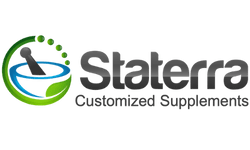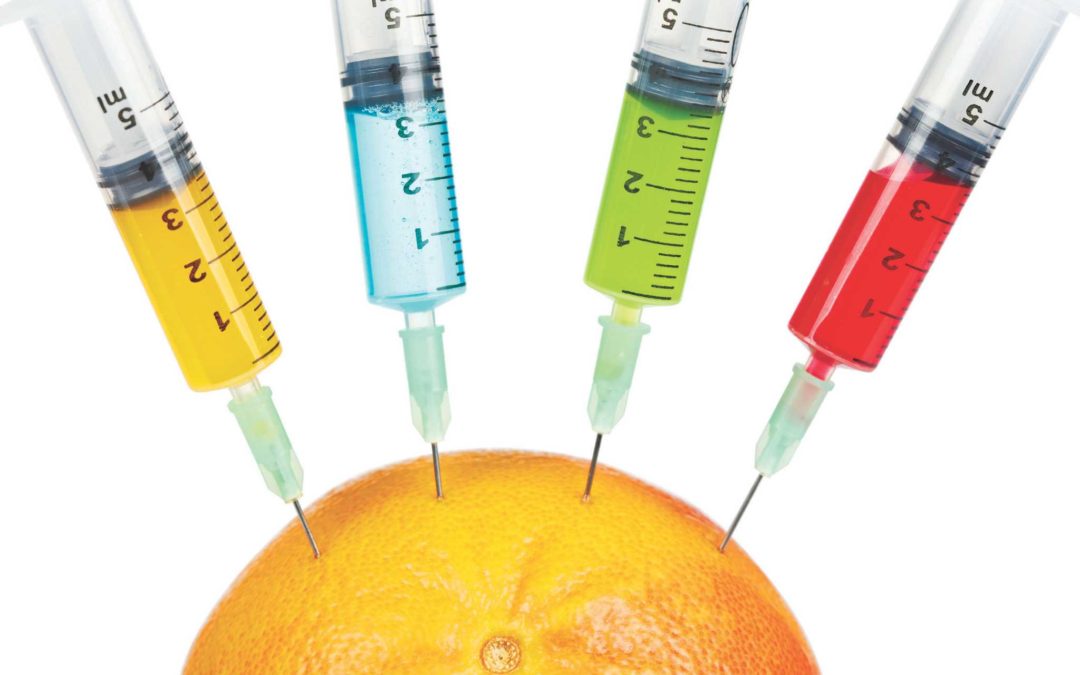Are you aware of the little-known, often lab-generated, flavour enhancing chemicals being pumped into your food? Look out for these five food additives the next time you go shopping.
Trans Fat
Found in deep-fried fast foods and certain processed foods made with margarine or partially hydrogenated vegetable oils, trans fats are formed by a process called hydrogenation. They have been incorporated into many food products to improve stability during cooking, increase shelf life, and boost flavour. Health Canada aims to add trans fats to its “List of Contaminants and Other Adulterating Substances in Foods,” as numerous studies now show that the consumption of trans fat increases the risk of heart attacks, heart disease and strokes, and contributes to increased inflammation, insulin resistance, and obesity. (1)
Can be found in: margarine, pies, cakes, cookies, crackers, frozen pizzas, doughnuts.
High Fructose Corn Syrup
High fructose corn syrup (HFCS) is a manmade sweetener that can be found in a wide range of processed food products, from crackers and cereals to ketchup and salad dressings. Originally introduced as a cost-effective sweeter in the American diet, long-term consumption of HFCS is now shown to lead to abnormal increases in body fat, especially in the abdomen, along with the development of diabetes and tissue damage, among other harmful effects. (2)
Can be found in: fruit juice, soda, cereal, bread, yogurt, ketchup, mayonnaise.
Food Dyes
Artificial food dyes are derived from petroleum and can be found in many food products marketed to children, such as fruit juices, breakfast cereals, vitamins, soda, and salad dressings. In 2010 a report from the Centre for Science in the Public Interest (CSPI) concluded that such food dyes, approved in the United States, likely cause behavioural and hypersensitivity problems, are carcinogenic, or have been inadequately tested. (4)
Even fresh fruits and vegetables aren’t safe, as Michael Jacobson, executive director of CSPI, notes that fresh oranges are sometimes dipped in dye to provide uniform colour and brighten them up. According to the International Association of Colour Manufacturers (IACM), artificial colour additives “provide a colourful identity to foods that would otherwise be virtually colourless” (5), and assists in compensating for colour loss that occurs naturally during product storage.
Out of the nine artificial dyes mentioned by the CSPI, here are three that you absolutely need to watch out for:
- BLUE #1: May inhibit cell respiration, and has been linked to asthma, allergies, and ADHD. The FDA issued a public health advisory in 2003 when Blue #1 (Brilliant Blue) was used in feeding tubes, because of such side effects as blue-tinged urine and skin, as well as hypotension and death. (6)
Can be found in: cereal, candy, soft drinks, sports drinks.
- RED #3: In 1990 RED #3 was banned in the use of some cosmetics, drugs, and food products, when it was shown to cause thyroid cancer and chromosomal damage in laboratory animals. This dye continues to be on the market, however, until supplies run out.
Can be found in: maraschino cherries, candy, ice cream, bakery products.
- YELLOW #5 (or TARTRAZINE): Often used as a cheap alternative to beta-carotene to colour food and enhance visual appeal, Yellow #5 has been shown in studies to increase symptoms associated with Carpal Tunnel Syndrome. It has also been linked to many other health problems, including migraines, blurred vision, anxiety, and fatigue.
Can be found in: cereal, cheese products, candy, margarine, pasta.
Sodium Nitrate/Sodium Nitrite
Sodium nitrate accumulates in fruits and vegetables from fertilizers, and is also used a colorant, preservative, and flavouring component in processed meats. This ingredient is considered hazardous in high concentrations once it enters the digestive system, as the body converts nitrate to nitrite. It’s believed that sodium nitrate may damage blood vessels, harden and narrow arteries, and potentially lead to heart disease. According to the World Health Organization (WHO), “meat processing such as curing (e.g. by adding nitrates or nitrites) or smoking can lead to the formation of potentially cancer-causing (carcinogenic) chemicals such as N-nitroso-compounds (NOC) and polycyclic aromatic hydrocarbons (PAH).” (7)
Can be found in: bacon, ham, hotdogs, luncheon meats, cured meats, smoked fish.
BHA and BHT
Butylated hydroxyanisole (BHA) and butylated hydrozyttoluene (BHT) are common preservatives that help to keep foods from changing in flavour, altering in colour, or becoming rancid. Although it is believed to be safe in small doses, it large amounts both BHA and BHT have been known to effect the neurological system of the brain, and cause severe abdominal cramping, vomiting, and nausea. In their report on Carcinogens, The US Department of Health and Human Services states that BHA is “reasonably anticipated to be a human carcinogen based on sufficient evidence of carcinogenicity in experimental animals.” (8)
Can be found in: Potato chips, gum, cereal, frozen sausages, enriched rice, lard, shortening, candy, jello.
References:
- Health Canada proposes trans fat ban. CBC News Posted: Apr 07, 2017: http://www.cbc.ca/news/health/trans-fats-1.4061489
- Hilary Parker. A sweet problem: Princeton researchers find that high-fructose corn syrup prompts considerably more weight gain. Princeton University. March 22, 2010.
- American Chemical Society. Soda Warning-high-fructose corn syrup linked to diabetes, new study suggests. ScienceDaily. Aug 23, 2007
- CSPI. Food Dyes: A Rainbow of Risks. Washington, DC: Center for Science in the Public Interest; 2010: http://tinyurl.com/2dsxlvd
- IACM. International Association of Colour Manufacturers Reaffirms Safety of Food Dyes. Washington, DC: International Association of Colour Manufacturers. Jun 29, 2010: http://tinyurl.com/2dlu9h2
- FDA Public Health Advisory: Subject: Reports of Blue Discolouration and Death in Patients Receiving Enteral Feedings Tinted With The Dye, FD&C Blue No. 1. Sept 29, 2003: https://www.fda.gov/forindustry/coloradditives/coloradditivesinspecificproducts/inmedicaldevices/ucm142395.htm
- WHO report says eating processed meat is carcinogenic: Understanding the findings. Harvard School of Public Health. Nov 3, 2015: https://www.hsph.harvard.edu/nutritionsource/2015/11/03/report-says-eating-processed-meat-is-carcinogenic-understanding-the-findings/
- Sharla Race. Antioxidants: The truth about BHA, BHT, TBHQ and other antioxidants used as food additives. 2009: http://www.foodcanmakeyouill.co.uk/uploads/1/2/7/4/12746572/antioxidants.pdf
Photo Credit: Rafa Frusta – Fotolia (http://www.timesunion.com/living/article/Know-pros-and-cons-of-additives-4243676.php)

